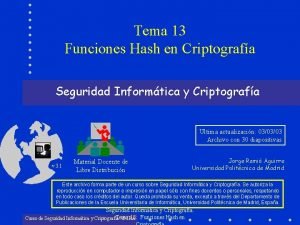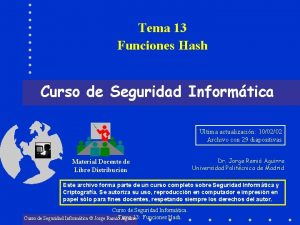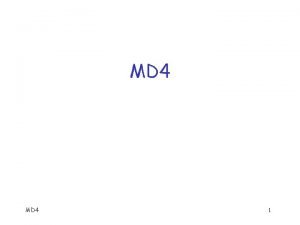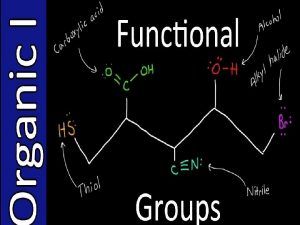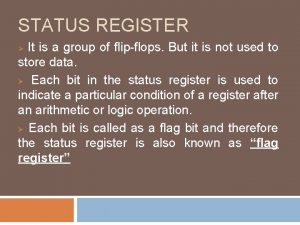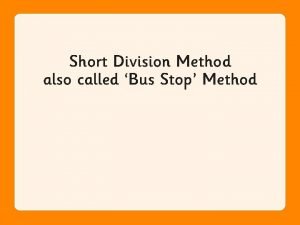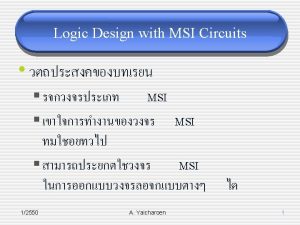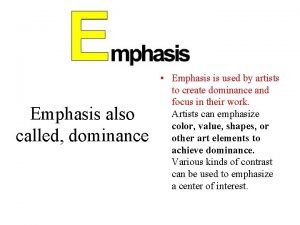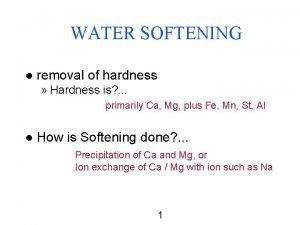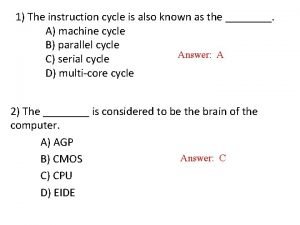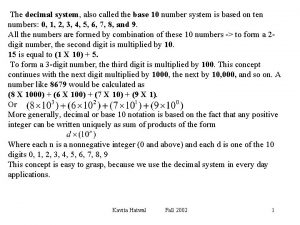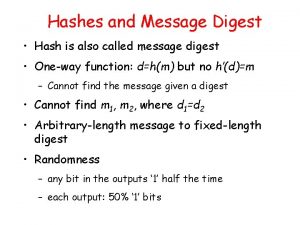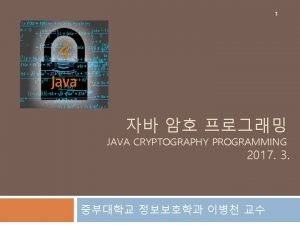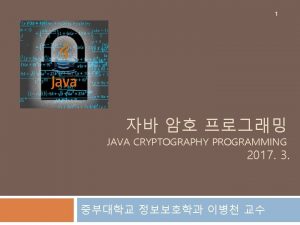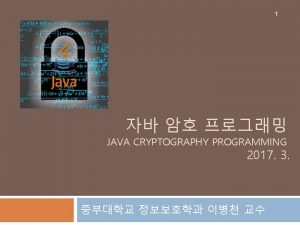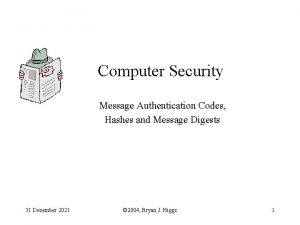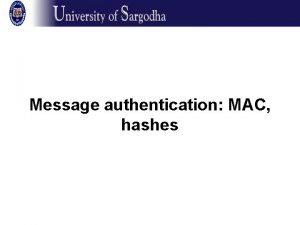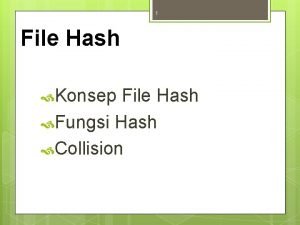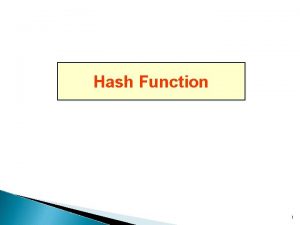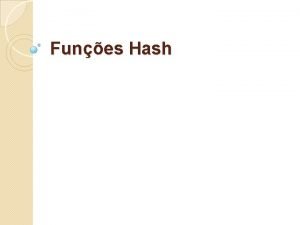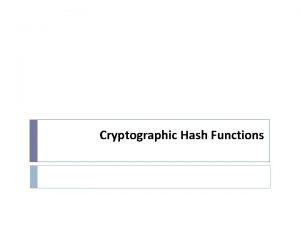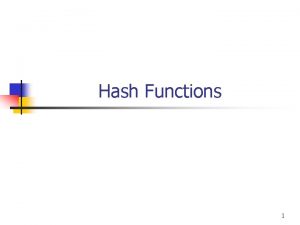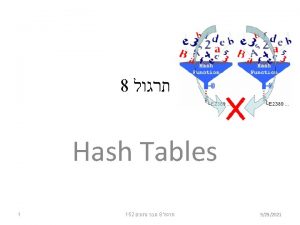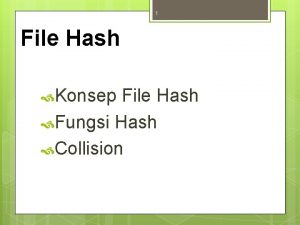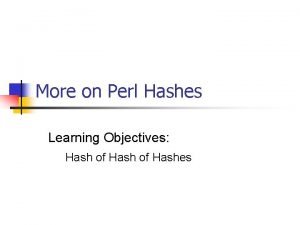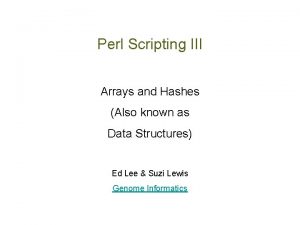Hashes and Message Digest Hash is also called


























































- Slides: 58

Hashes and Message Digest • Hash is also called message digest • One-way function: d=h(m) but no h’(d)=m – Cannot find the message given a digest • Cannot find m 1, m 2, where d 1=d 2 • Arbitrary-length message to fixed-length digest • Randomness – any bit in the outputs ‘ 1’ half the time – each output: 50% ‘ 1’ bits

Birthday Problem • How many people do you need so that the probability of having two of them share the same birthday is > 50% ? • Random sample of n birthdays (input) taken from k (365, output) • kn total number of possibilities • (k)n=k(k-1)…(k-n+1) possibilities without duplicate birthday • Probability of no repetition: – p = (k)n/kn 1 - n(n-1)/2 k • For k=366, minimum n = 23 • n(n-1)/2 pairs, each pair has a probability 1/k of having the same output • n(n-1)/2 k > 50% n>k 1/2

How Many Bits for Hash? • m bits, takes 2 m/2 to find two with the same hash • 64 bits, takes 232 messages to search (doable) • Need at least 128 bits

Using Hash for Authentication • Alice to Bob: challenge r. A • Bob to Alice: MD(KAB|r. A) • Bob to Alice: r. B • Alice to Bob: MD(KAB|r. B) • Only need to compare MD results

Using Hash to Encrypt • One-time pad with KAB – Compute bit streams using MD, and K • b 1=MD(KAB), bi=MD(KAB|bi-1), … – with message blocks – Add a random 64 bit number (aka IV) b 1=MD(KAB|IV), bi=MD(KAB|bi-1), …

General Structure of Secure Hash Code • Iterative compression function – Each f is collision-resistant, so is the resulting hashing

MD 5: Message Digest Version 5 input Message Output 128 bits Digest • Until recently the most widely used hash algorithm – in recent times have both brute-force & cryptanalytic concerns • Specified as Internet standard RFC 1321

MD 5 Overview

MD 5 Overview 1. Pad message so its length is 448 mod 512 2. Append a 64 -bit original length value to message 3. Initialise 4 -word (128 -bit) MD buffer (A, B, C, D) 4. Process message in 16 -word (512 -bit) blocks: – Using 4 rounds of 128 bit operations on message block & buffer – Add output to buffer input to form new buffer value 5. Output hash value is the final buffer value

Padding Twist • Given original message M, add padding bits “ 10*” such that resulting length is 64 bits less than a multiple of 512 bits. • Append (original length in bits mod 264), represented in 64 bits to the padded message • Final message is chopped 512 bits a block

MD 5 Process • As many stages as the number of 512 -bit blocks in the final padded message • Digest: 4 32 -bit words: MD=A|B|C|D • Every message block contains 16 32 -bit words: m 0|m 1|m 2…|m 15 – Digest MD 0 initialized to: A=01234567, B=89 abcdef, C=fedcba 98, D=76543210 – Every stage consists of 4 passes/rounds over the message block, each modifying MD • Each block 4 rounds, each round 16 passes

Processing of Block mi - 4 Passes mi MDi ABCD=f. F(ABCD, mi, T[1. . 16]) A C B D ABCD=f. G(ABCD, mi, T[17. . 32]) ABCD=f. H(ABCD, mi, T[33. . 48]) ABCD=f. I(ABCD, mi, T[49. . 64]) + MD i+1 + + +

Each Block Has 4 Rounds and 64 Steps Each step t (0 <= t <= 63): • Input: – mt – a 32 -bit word from the message With different shift every round – Tt – int(232 * abs(sin(i))), 0<i<65 Provided a randomized set of 32 -bit patterns, which eliminate any regularities in the input data – ABCD: current MD • Output: – ABCD: new MD

MD 5 Compression Function

Secure Hash Algorithm • Developed by NIST, specified in the Secure Hash Standard (SHS, FIPS Pub 180), 1993 • SHA is specified as the hash algorithm in the Digital Signature Standard (DSS), NIST

General Logic • Input message must be < 264 bits – not really a problem • Message is processed in 512 -bit blocks sequentially • Message digest is 160 bits • SHA design is similar to MD 5, but a lot stronger

Basic Steps Step 1: Padding Step 2: Appending length as 64 bit unsigned Step 3: Initialize MD buffer 5 32 -bit words Store in big endian format, most significant bit in low address A|B|C|D|E A = 67452301 B = efcdab 89 C = 98 badcfe D = 10325476 E = c 3 d 2 e 1 f 0

Basic Steps. . . Step 4: the 80 -step processing of 512 -bit blocks – 4 rounds, 20 steps each. Each step t (0 <= t <= 79): – Input: • Wt – a 32 -bit word from the message • Kt – a constant. • ABCDE: current MD. – Output: • ABCDE: new MD.

SHA-1 verses MD 5 • Brute force attack is harder (160 vs 128 bits for MD 5) • Not vulnerable to any known cryptanalytic attacks (compared to MD 4/5) • A little slower than MD 5 (80 vs 64 steps) – Both work well on a 32 -bit architecture • Both designed as simple and compact for implementation

Revised Secure Hash Standard • NIST have issued a revision FIPS 180 -2 • adds 3 additional hash algorithms • SHA-256, SHA-384, SHA-512 • designed for compatibility with increased security provided by the AES cipher • structure & detail is similar to SHA-1 • hence analysis should be similar

Outline • User authentication – Password authentication, salt – Challenge-Response – Biometrics – Token-based authentication • Authentication in distributed systems (multi service providers/domains) – Single sign-on, Microsoft Passport – Trusted Intermediaries

Password authentication • Basic idea – User has a secret password – System checks password to authenticate user • Issues – How is password stored? – How does system check password? – How easy is it to guess a password? • Difficult to keep password file secret, so best if it is hard to guess password even if you have the password file

Basic password scheme User Password file kiwifruit hash function exrygbzyf kgnosfix ggjoklbsz … …

Basic password scheme • Hash function h : strings – Given h(password), hard to find password – No known algorithm better than trial and error • User password stored as h(password) • When user enters password – System computes h(password) – Compares with entry in password file • No passwords stored on disk

Unix password system • Hash function is 25 x. DES – 25 rounds of DES-variant encryptions • Password file is publicly readable – Other information in password file … • Any user can try “dictionary attack” – User looks at password file – Computes hash(word) for every word in dictionary • “Salt” makes dictionary attack harder R. H. Morris and K. Thompson, Password security: a case history, Communications of the ACM, November 1979

Salt • Password line walt: f. URfuu 4. 4 h. Y 0 U: 129: Belgers: /home/walt: /bin/csh Compare Input Salt Key Constant, A 64 -bit block of 0 25 x DES Ciphertext Plaintext When password is set, salt is chosen randomly 12 -bit salt slows dictionary attack by factor of 212

Dictionary Attack – some numbers • Typical password dictionary – 1, 000 entries of common passwords • people's names, common pet names, and ordinary words. – Suppose you generate and analyze 10 guesses per second • This may be reasonable for a web site; offline is much faster – Dictionary attack in at most 100, 000 seconds = 28 hours, or 14 hours on average • If passwords were random – Assume six-character password • Upper- and lowercase letters, digits, 32 punctuation characters • 689, 869, 781, 056 password combinations. • Exhaustive search requires 1, 093 years on average

Challenge-response Authentication Goal: Bob wants Alice to “prove” her identity to him Protocol ap 1. 0: Alice says “I am Alice” Failure scenario? ?

Authentication Goal: Bob wants Alice to “prove” her identity to him Protocol ap 1. 0: Alice says “I am Alice” in a network, Bob can not “see” Alice, so Trudy simply declares herself to be Alice

Authentication: another try Protocol ap 2. 0: Alice says “I am Alice” in an IP packet containing her source IP address Alice’s “I am Alice” IP address Failure scenario? ?

Authentication: another try Protocol ap 2. 0: Alice says “I am Alice” in an IP packet containing her source IP address Alice’s IP address Trudy can create a packet “spoofing” “I am Alice” Alice’s address

Authentication: another try Protocol ap 3. 0: Alice says “I am Alice” and sends her secret password to “prove” it. Alice’s “I’m Alice” IP addr password Alice’s IP addr OK Failure scenario? ?

Authentication: another try Protocol ap 3. 0: Alice says “I am Alice” and sends her secret password to “prove” it. Alice’s “I’m Alice” IP addr password Alice’s IP addr OK playback attack: Trudy records Alice’s packet and later plays it back to Bob Alice’s “I’m Alice” IP addr password

Authentication: yet another try Protocol ap 3. 1: Alice says “I am Alice” and sends her encrypted secret password to “prove” it. Alice’s encrypted “I’m Alice” IP addr password Alice’s IP addr OK Failure scenario? ?

Authentication: another try Protocol ap 3. 1: Alice says “I am Alice” and sends her encrypted secret password to “prove” it. Alice’s encryppted “I’m Alice” IP addr password Alice’s IP addr OK Alice’s encrypted “I’m Alice” IP addr password record and playback still works!

Authentication: yet another try Goal: avoid playback attack Nonce: number (R) used only once –in-a-lifetime ap 4. 0: to prove Alice “live”, Bob sends Alice nonce, R. Alice must return R, encrypted with shared secret key “I am Alice” R KA-B(R) Failures, drawbacks? Alice is live, and only Alice knows key to encrypt nonce, so it must be Alice!

Authentication: ap 5. 0 ap 4. 0 doesn’t protect against server database reading • can we authenticate using public key techniques? ap 5. 0: use nonce, public key cryptography “I am Alice” R - K A (R) Bob computes + - KA(KA (R)) = R and knows only Alice could have the private key, that encrypted R such that + K (K (R)) = R A A

Biometrics • Use a person’s physical characteristics – fingerprint, voice, face, keyboard timing, … • Advantages – Cannot be disclosed, lost, forgotten • Disadvantages – Cost, installation, maintenance – Reliability of comparison algorithms • False positive: Allow access to unauthorized person • False negative: Disallow access to authorized person – Privacy? – If forged, how do you revoke?

Biometrics • Common uses – Specialized situations, physical security – Combine • Multiple biometrics • Biometric and PIN • Biometric and token

Token-based authentication Smart Card • With embedded CPU and memory • Various forms – PIN protected memory card • Enter PIN to get the password – Cryptographic challenge/response cards • A cryptographic key in memory • Computer create a random challenge • Enter PIN to encrypt/decrypt the challenge w/ the card

Smart Card Example Initial data Time Challenge function • Some complications – Initial data shared with server • Need to set this up securely • Shared database for many sites – Clock skew Time

Outline • User authentication – Password authentication, salt – Challenge-Response – Biometrics – Token-based authentication • Authentication in distributed systems – Single sign-on, Microsoft Passport – Trusted Intermediaries

Single sign-on systems e. g. Securant, Netegrity, Oblix LAN Rules user name, password, other auth Authenticati on Database Application Server • Advantages – User signs on once – No need for authentication at multiple sites, applications – Can set central authorization policy for the enterprise

Microsoft Passport • Launched 1999 – Claim > 200 million accounts in 2002 – Over 3. 5 billion authentications each month • Log in to many websites using one account – Used by MS services Hotmail, MSN Messenger or MSN subscriptions; also Radio Shack, etc. – Hotmail or MSN users automatically have Microsoft Passport accounts set up • Passport may continue to evolve; bugs have been uncovered

Four parts of Passport account • Passport Unique Identifier (PUID) – Assigned to the user when he or she sets up the account • User profile, required to set up account – Phone number or Hotmail or MSN. com e-mail address – Also name, ZIP code, state, or country, … • Credential information – E-mail address or phone number – Minimum six-character password or PIN – Four-digit security key, used for a second level of authentication on sites requiring stronger sign-in credentials • Wallet – Passport-based application at passport. com domain – E-commerce sites with Express Purchase function use wallet information rather than prompt the user to type in data

Passport log-in

Trusted Intermediaries Symmetric key problem: Public key problem: • How do two entities establish shared secret key over network? • When Alice obtains Bob’s public key (from web site, e-mail, diskette), how does she know it is Bob’s public key, not Trudy’s? Solution: • trusted key distribution center (KDC) acting as intermediary between entities Solution: • trusted certification authority (CA)

Key Distribution Center (KDC) • Alice, Bob need shared symmetric key. • KDC: server shares different secret key with each registered user (many users) • Alice, Bob know own symmetric keys, KA-KDC KB-KDC , for communicating with KDC KA-KDC KP-KDC KB-KDC KA-KDC KX-KDC KY-KDC KB-KDC KZ-KDC

Key Distribution Center (KDC) Q: How does KDC allow Bob, Alice to determine shared symmetric secret key to communicate with each other? KDC generates R 1 KA-KDC(A, B) Alice knows R 1 KA-KDC(R 1, KB-KDC(A, R 1) ) KB-KDC(A, R 1) Bob knows to use R 1 to communicate with Alice and Bob communicate: using R 1 as session key for shared symmetric encryption

Certification Authorities • Certification authority (CA): binds public key to particular entity, E. • E (person, router) registers its public key with CA. – E provides “proof of identity” to CA. – CA creates certificate binding E to its public key. – certificate containing E’s public key digitally signed by CA – CA says “this is E’s public key” Bob’s public key Bob’s identifying information + KB digital signature (encrypt) CA private key K- CA + KB certificate for Bob’s public key, signed by CA

Certification Authorities • When Alice wants Bob’s public key: – gets Bob’s certificate (Bob or elsewhere). – apply CA’s public key to Bob’s certificate, get Bob’s public key + KB digital signature (decrypt) CA public key + K CA Bob’s public + key KB

Single KDC/CA • Problems – Single administration trusted by all principals – Single point of failure – Scalability • Solutions: break into multiple domains – Each domain has a trusted administration

Multiple KDC/CA Domains Secret keys: • KDCs share pairwise key • topology of KDC: tree with shortcuts Public keys: • cross-certification of CAs • example: Alice with CAA, Boris with CAB – Alice gets CAB’s certificate (public key p 1), signed by CAA – Alice gets Boris’ certificate (its public key p 2), signed by CAB (p 1)

Backup Slides

MD 5 Compression Function • Each round has 16 steps of the form: a = b+((a+g(b, c, d)+X[k]+T[i])<<<s) • a, b, c, d refer to the 4 words of the buffer, but used in varying permutations – note this updates 1 word only of the buffer – after 16 steps each word is updated 4 times • where g(b, c, d) is a different nonlinear function in each round (F, G, H, I)

Functions and Random Numbers • F(x, y, z) == (x y) (~x z) – selection function • G(x, y, z) == (x z) (y ~ z) • H(x, y, z) == x y z • I(x, y, z) == y (x ~z)

Basic Steps. . . • Only 4 per-round distinctive additive constants 0 <=t<= 19 Kt = 5 A 827999 20<=t<=39 Kt = 6 ED 9 EBA 1 40<=t<=59 Kt = 8 F 1 BBCDC 60<=t<=79 Kt = CA 62 C 1 D 6

Advantages of salt • Without salt – Same hash functions on all machines • Compute hash of all common strings once • Compare hash file with all known password files • With salt – One password hashed 212 different ways • Precompute hash file? – Need much larger file to cover all common strings • Dictionary attack on known password file – For each salt found in file, try all common strings
 Tema de hash hash
Tema de hash hash Tema de hash hash
Tema de hash hash Message digest java
Message digest java Message digest 4
Message digest 4 Message signature hash
Message signature hash Shark class
Shark class Uninformed search examples
Uninformed search examples Input and output of krebs cycle
Input and output of krebs cycle Specification-based testing
Specification-based testing Trachea is also called
Trachea is also called A workbook is also called a
A workbook is also called a Spider phylum
Spider phylum Formal spectacles
Formal spectacles It is also called figurative language
It is also called figurative language What is vowel glide
What is vowel glide Citric acid cycle also called
Citric acid cycle also called Chasse locomotor or non locomotor
Chasse locomotor or non locomotor Alkanes list
Alkanes list Status register
Status register Division bus stop
Division bus stop Womb is also called
Womb is also called The raster scan display the frame buffer holds
The raster scan display the frame buffer holds Is also called as data selector.
Is also called as data selector. Circle graph is also called
Circle graph is also called Womb is also called
Womb is also called Formal equivalence examples filipino
Formal equivalence examples filipino Womb is also called
Womb is also called Womb is also called
Womb is also called 4-adjacency 8-adjacency m-adjacency example
4-adjacency 8-adjacency m-adjacency example Womb is also called
Womb is also called Ppp byte stuffing
Ppp byte stuffing Application of ac voltage controller
Application of ac voltage controller Brief work of fiction
Brief work of fiction Dominant emphasis
Dominant emphasis Economic resources are also called:
Economic resources are also called: Methods of teaching english
Methods of teaching english Physiologic population density
Physiologic population density Anti-hemorrhagic vitamin
Anti-hemorrhagic vitamin Permanent hardness is also called as
Permanent hardness is also called as Royalty account is *
Royalty account is * Modals are also called
Modals are also called What are the osha construction standards also called
What are the osha construction standards also called Osha 29cfr1910.134
Osha 29cfr1910.134 Scqa analysis
Scqa analysis Chuseok also called
Chuseok also called Auxiliary verbs are also called
Auxiliary verbs are also called Adjective are also called
Adjective are also called A network adapter also called a ____
A network adapter also called a ____ Distributive couplers are also called as
Distributive couplers are also called as Joints are also called
Joints are also called Tree is a connected graph without any
Tree is a connected graph without any Decimal system is also called as
Decimal system is also called as Bench terrace sloping inward
Bench terrace sloping inward Parallel structures are also called
Parallel structures are also called Complex carbohydrates are also called
Complex carbohydrates are also called Mc clellands theory of motivation is also called as
Mc clellands theory of motivation is also called as Formic aldehyde
Formic aldehyde Whats technical school
Whats technical school A dependent clause is also called a
A dependent clause is also called a
